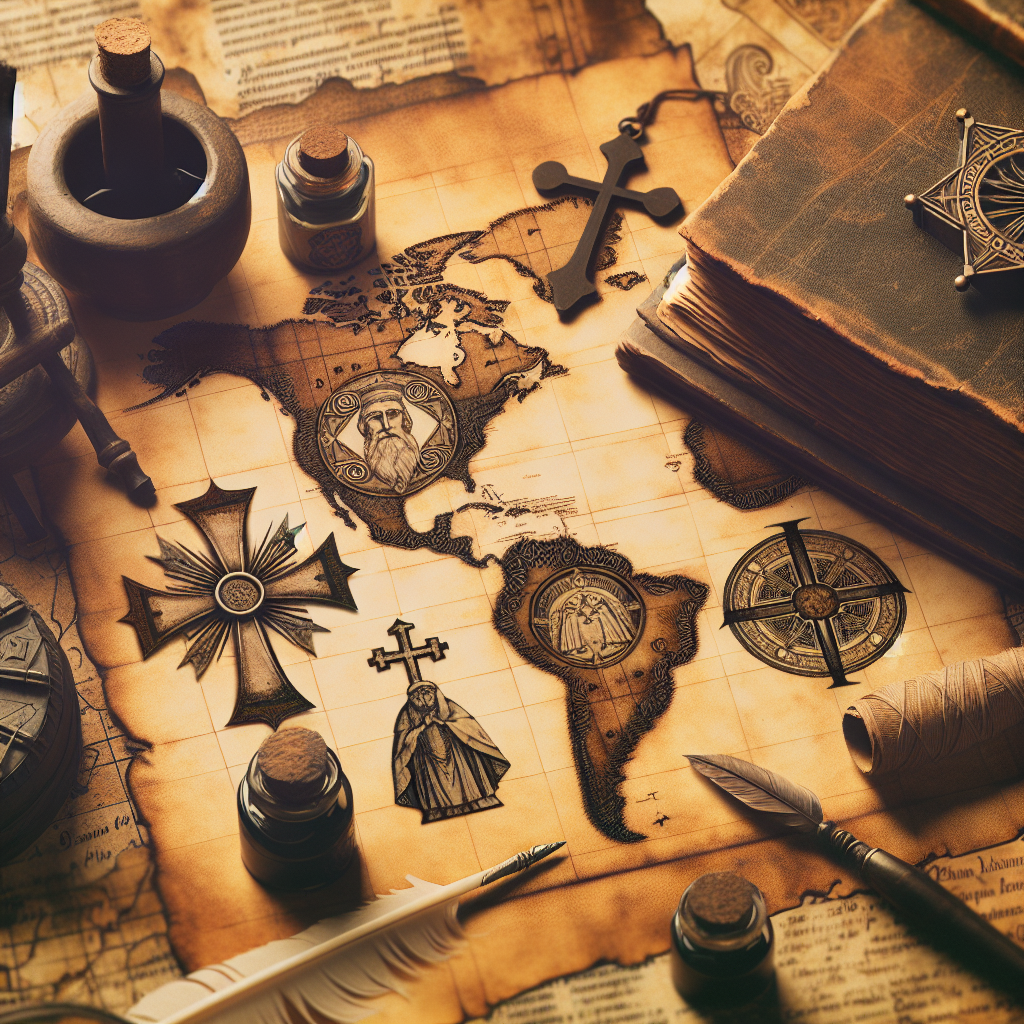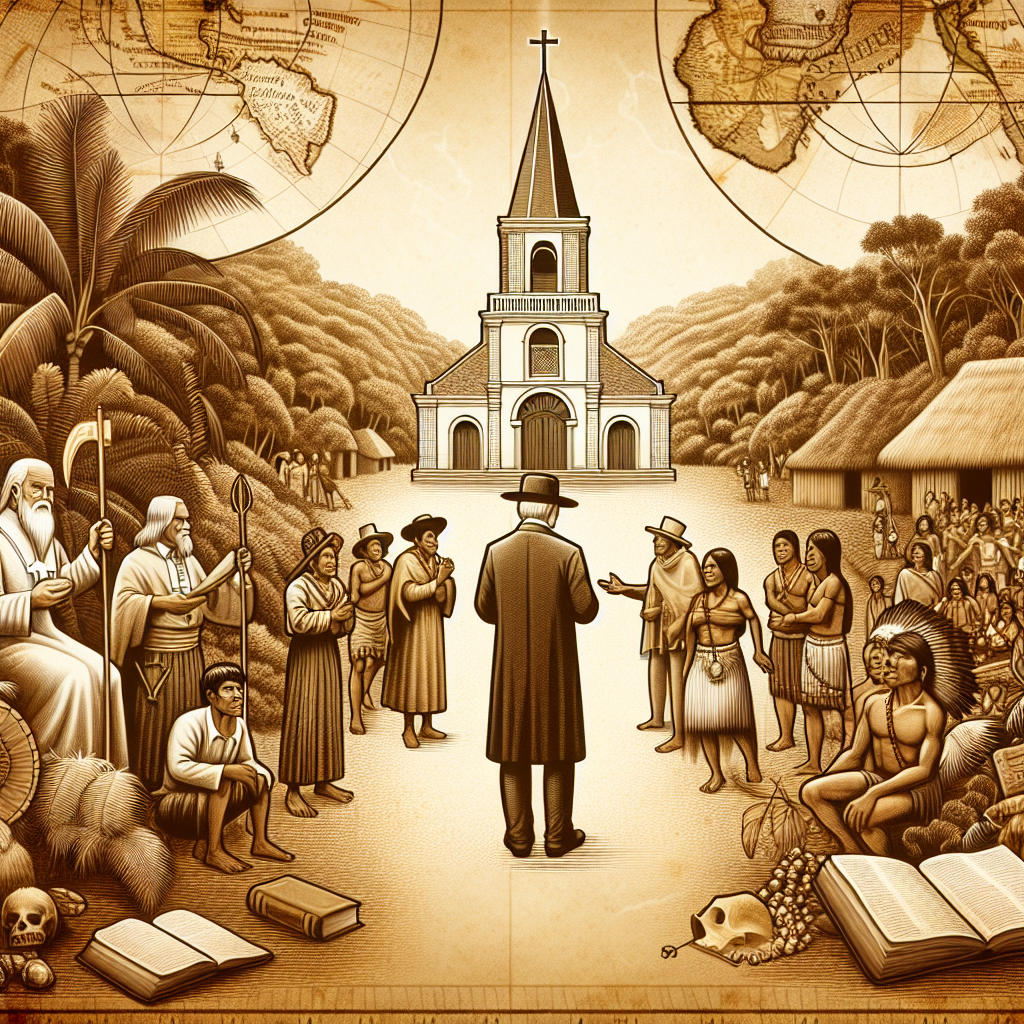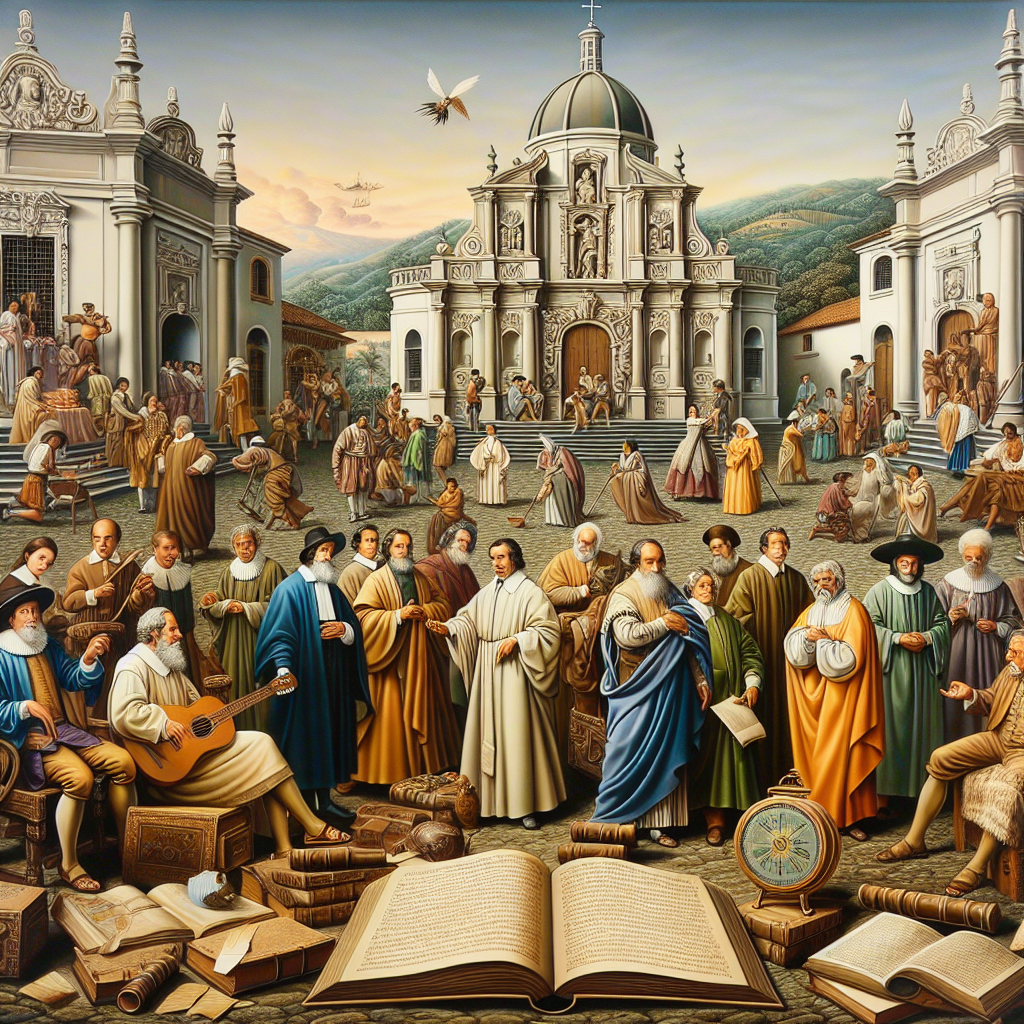In the historical narrative of Latin American colonization, religion played a pivotal and complex role. As European powers swept across the region, they brought with them not just their armies, but also their religious beliefs. The Catholic Church, in particular, wielded immense influence in shaping the social, cultural, and political landscape of the colonies. From converting indigenous populations to serving as a tool of control and justification for colonization, religion left an indelible mark on the history of Latin America. This exploration delves into the intricate relationship between religion and colonization, shedding light on the multifaceted dynamics that defined this crucial period of history.
The Pre-Colonial Religious Landscape of Latin America

Overview of Indigenous Belief Systems
Indigenous belief systems in pre-colonial Latin America were diverse and intricate, varying greatly among different tribes and civilizations. For example, the Aztecs in Mesoamerica worshipped a pantheon of gods, with each deity representing different aspects of life such as agriculture, war, and fertility. In contrast, the Inca civilization in the Andean region revered Inti, the sun god, as the most important deity. These belief systems were deeply intertwined with daily life, influencing everything from agricultural practices to social hierarchies.
Influence of Religion on Societal Structure
Religion played a central role in shaping the societal structure of pre-colonial Latin America. Priests and religious leaders held significant power and authority, often acting as intermediaries between the people and the gods. In many societies, religious ceremonies and rituals were intricately linked to political events and social gatherings, reinforcing the importance of spiritual beliefs in maintaining order and cohesion within communities. Social classes were often defined by one’s proximity to religious practices, with elites having greater access to religious knowledge and rituals.
Spiritual Practices and Rituals
Spiritual practices and rituals were an integral part of daily life for indigenous peoples in pre-colonial Latin America. Ceremonies honoring the gods were performed regularly, often accompanied by offerings of food, drink, and precious items. Shamans and spiritual healers played a crucial role in guiding individuals through important life events such as birth, marriage, and death. These rituals were not only a means of connecting with the divine but also served to strengthen social bonds and reinforce cultural identity within indigenous communities.

The Arrival of European Colonizers in Latin America
Upon arriving in Latin America, European colonizers brought with them not only their advanced weaponry and technology but also their religious beliefs. This marked the beginning of a significant shift in the spiritual landscape of the region, as Christianity was introduced to the indigenous populations that had inhabited these lands for centuries. The Spanish and Portuguese settlers, driven by a sense of religious fervor and a desire to spread the teachings of their faith, embarked on extensive conversion efforts aimed at converting the native peoples to Christianity.
The intricate role of religion in Latin American colonization is evident in the diverse pre-colonial indigenous belief systems, the clash of religious beliefs and practices during European colonization, and the enduring influence of Catholicism in shaping the cultural, social, and political landscape of the region. Religious syncretism, challenges, controversies, and the evolution of religious practices in post-colonial Latin America reflect the complex interplay between traditional beliefs and external influences, highlighting the resilience and adaptability of indigenous spirituality amidst colonization.
Introduction of Christianity to the Indigenous Populations
The introduction of Christianity to the indigenous populations of Latin America was a complex and multifaceted process. European missionaries, including members of religious orders such as the Franciscans, Dominicans, and Jesuits, played a central role in this endeavor. They sought to impart the tenets of the Christian faith to the indigenous peoples through a combination of preaching, religious instruction, and the establishment of missions and churches.
Conversion Efforts by Spanish and Portuguese Settlers
Spanish and Portuguese settlers viewed the conversion of the indigenous populations to Christianity as a crucial aspect of their colonial mission. They believed that by converting the native peoples to Christianity, they could not only save their souls but also facilitate their assimilation into European culture and society. As such, extensive efforts were made to convert the indigenous populations, often through a combination of persuasion, coercion, and the imposition of religious practices and rituals.
Clash of Religious Beliefs and Practices
The clash of religious beliefs and practices between the European colonizers and the indigenous populations of Latin America was inevitable. The traditional spiritual beliefs and practices of the native peoples often conflicted with the teachings of Christianity, leading to tensions and conflicts. The imposition of Christianity by force in some cases further exacerbated these conflicts, as the indigenous populations resisted efforts to eradicate their own spiritual traditions in favor of the new faith brought by the colonizers.
Impact of Religion on Colonial Policies
- Encomienda system and religious justifications
The encomienda system was a key component of colonial policies in Latin America, allowing conquistadors to claim land and exploit indigenous labor. The Spanish crown granted encomiendas to individuals, who in turn were responsible for the conversion and “civilization” of the indigenous populations under their control. This system was heavily influenced by religious justifications, as the Catholic Church played a crucial role in promoting the idea that the conquest and subjugation of indigenous peoples was justified in the name of spreading Christianity. Missionaries often worked closely with encomenderos to ensure that indigenous communities were indoctrinated into the Catholic faith, further legitimizing the exploitation of native populations.
- Role of the Catholic Church in colonization
The Catholic Church wielded significant power and influence in the process of Latin American colonization. Spanish and Portuguese monarchs worked closely with the Church to solidify their control over newly acquired territories, using religious doctrine to justify their actions. The Church played a central role in the conversion of indigenous peoples, establishing missions and schools to instill Catholic beliefs and practices. Additionally, the Church acted as a mediator between colonizers and indigenous populations, often serving as a voice of authority and control in colonial affairs. The presence of the Catholic Church not only facilitated the spread of Christianity but also provided a moral and ethical framework through which colonial policies were implemented and enforced.
- Religious motivations behind conquest and expansion
Religious motivations were deeply intertwined with the conquest and expansion efforts of European colonizers in Latin America. The doctrine of “divine right” was frequently invoked to justify the subjugation of indigenous peoples, with colonizers viewing themselves as instruments of God’s will in bringing Christianity to the New World. Missionaries and clergy played a key role in promoting the idea of religious superiority, portraying indigenous beliefs and practices as pagan and in need of salvation. The pursuit of converting native populations to Christianity was not only a religious duty but also a means of exerting control and dominance over conquered territories. The fusion of religious fervor with imperial ambitions fueled the expansion of European powers in Latin America, shaping the course of colonization and leaving a lasting impact on the region’s cultural and social landscape.
Resistance and Adaptation of Indigenous Religions
The resistance and adaptation of indigenous religions in the face of European colonization in Latin America were complex processes that shaped the region’s religious landscape. The arrival of European colonizers brought with them the imposition of Christianity, leading to a clash of beliefs and practices between the indigenous populations and the newcomers.
- Syncretism between indigenous beliefs and Christianity
- Indigenous communities often engaged in a process of syncretism, where they integrated elements of their traditional beliefs with Christian teachings. This syncretic approach allowed for the preservation of certain aspects of indigenous spirituality while outwardly conforming to the dominant religion of the colonizers.
-
Through syncretism, indigenous peoples were able to maintain a sense of cultural identity and spiritual connection to their ancestors, even in the face of religious persecution and pressure to convert.
-
Indigenous uprisings against religious oppression
- In response to the oppressive tactics employed by the European colonizers to enforce Christianity, indigenous communities staged uprisings to resist the forced conversion and cultural erasure. These uprisings were not only acts of defiance against religious oppression but also assertions of autonomy and self-determination.
-
The resistance of indigenous populations to the imposition of Christianity was a form of reclaiming their religious sovereignty and asserting their right to practice their traditional beliefs free from external interference.
-
Preservation of native spirituality amidst colonization
- Despite the challenges posed by European colonization and the spread of Christianity, many indigenous communities managed to preserve elements of their native spirituality through clandestine practices and hidden rituals. These acts of resistance were crucial in maintaining a sense of continuity with their cultural heritage and resisting the complete erasure of indigenous religions.

- The preservation of native spirituality amidst colonization served as a form of resilience and cultural survival for indigenous populations in Latin America, allowing them to navigate the complexities of religious syncretism and maintain a connection to their ancestral traditions.
The Legacy of Religion in Latin American Societies
Enduring Influence of Catholicism in Latin America
Since the arrival of Spanish and Portuguese colonizers in the 15th century, Catholicism has played a central role in shaping the cultural, social, and political landscape of Latin America. The missionaries who accompanied the conquistadors viewed the indigenous populations as heathens in need of salvation, leading to the widespread conversion of native peoples to Catholicism. This religious hegemony established by the colonizers has endured for centuries, with Catholicism becoming deeply entrenched in the fabric of Latin American societies.
The Catholic Church wielded significant power and influence during the colonial period, serving as both a spiritual authority and a political force. Missionaries not only spread the teachings of Christianity but also played a crucial role in the administration of the colonies, often acting as intermediaries between the colonizers and the indigenous populations. This close relationship between the Church and the ruling powers helped legitimize the conquest and subjugation of native peoples in the name of religion.
Religious Syncretism in Modern-Day Latin American Culture
Despite the enduring presence of Catholicism in Latin America, the region has also witnessed the emergence of religious syncretism, blending indigenous beliefs with Catholic traditions. This fusion of religious practices has given rise to unique cultural expressions, such as the celebration of festivals that combine elements of Catholic saints’ days with indigenous rituals and ceremonies.
Throughout Latin America, syncretic religious practices have flourished, reflecting the complex interplay between colonial legacies and indigenous traditions. For example, in countries like Mexico and Brazil, popular religious movements like the cult of the Virgin of Guadalupe and Candomblé incorporate elements of Catholicism with African spiritual beliefs brought by slaves, creating rich tapestries of faith that defy easy categorization.
Challenges and Controversies Surrounding the Historical Role of Religion
The historical role of religion in Latin American colonization has not been without its share of challenges and controversies. Critics argue that the imposition of Catholicism by the colonizers was a tool of cultural domination and oppression, aimed at erasing indigenous identities and traditions. The forced conversion of native peoples, often accompanied by violence and coercion, has left a legacy of trauma and resentment that continues to resonate in modern Latin American societies.
Moreover, the Catholic Church’s complicity in the atrocities committed during the colonial period, such as the encomienda system and the Inquisition, has sparked debates about accountability and reparations. Efforts to reckon with this dark chapter of history have led to calls for truth and reconciliation processes, as well as demands for greater recognition and respect for indigenous worldviews and spiritual practices.
Evolution of Religious Practices in Post-Colonial Latin America
The post-colonial era in Latin America saw a significant evolution in religious practices, marked by a diverse array of movements and shifts in traditional beliefs.
- Growth of Protestantism and other religious movements
- Following the colonization period dominated by Catholicism, the emergence and growth of Protestantism in Latin America brought about a new religious landscape.
- Protestant denominations, including Evangelical and Pentecostal churches, gained traction, attracting followers with their different worship styles and interpretations of the Bible.
-
This growth of Protestantism challenged the long-standing dominance of Catholicism in the region, leading to a more pluralistic religious environment.
-
Secularization trends in Latin American societies
- In the wake of colonization, secularization trends began to emerge in Latin American societies, influenced by factors such as modernization, urbanization, and globalization.
- As societies became more industrialized and interconnected with the global community, traditional religious practices and beliefs started to wane in some sectors of the population.
-
This shift towards secularization led to a decline in church attendance and religious adherence in certain regions, particularly among the younger generations.
-
Intersection of religion and politics in contemporary Latin America
- In contemporary Latin America, the intersection of religion and politics continues to play a complex and influential role in shaping societal norms and governance.
- Religious institutions and leaders often wield significant influence in political decision-making, advocating for policies aligned with their moral and ethical beliefs.
- This close relationship between religion and politics can both unite and divide communities, as differing religious perspectives may lead to conflicts over issues such as reproductive rights, LGBTQ rights, and social welfare programs.
FAQs
What role did religion play in Latin American colonization?
Religion played a crucial role in the colonization of Latin America, as Catholicism was used as a tool for converting indigenous populations to Christianity. Spanish and Portuguese colonizers believed it was their duty to spread the Christian faith to the New World, leading to the establishment of missions, churches, and schools throughout the region.
How did religion impact the treatment of indigenous peoples during colonization?
Religion often served as a justification for the mistreatment and displacement of indigenous peoples during colonization. The doctrine of the “civilizing mission” led colonizers to believe that indigenous communities needed to be converted and assimilated into European culture in order to be saved from damnation. This mindset often resulted in forced conversions, destruction of indigenous cultures and languages, and the exploitation of native populations.
How did the presence of religion influence the development of Latin American societies?
The presence of religion in Latin American colonization had a profound impact on the development of societies in the region. Catholicism became deeply embedded in the cultural, political, and social fabric of Latin America, shaping everything from governance systems to artistic expression. The blending of indigenous beliefs with Catholic practices also gave rise to unique religious traditions, such as syncretic forms of worship that are still practiced today.
Did the role of religion in colonization have any lasting effects on Latin American countries?
Yes, the role of religion in colonization has had lasting effects on Latin American countries. The imposition of Catholicism as the dominant religion led to a homogenization of religious practices and beliefs, which in turn influenced social norms, values, and institutions. Today, the legacy of colonization can still be felt in the strong presence of Catholicism in many Latin American countries, as well as the ongoing struggles for indigenous rights and recognition.
0 Comments